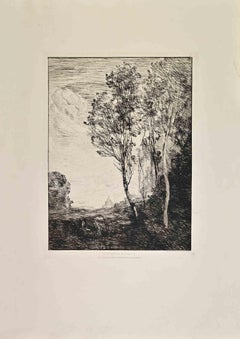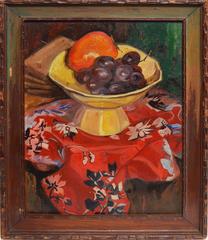Saul Raskin Art
to
1
Overall Width
to
Overall Height
to
1
1
1
1
1
1
1
1
9,989
2,754
1,378
1,375
1
Artist: Saul Raskin
Saul Raskin, The Cry of Union Square, about 1935
By Saul Raskin
Located in New York, NY
Saul Raskin's Cry of Union Square, has all my favorite things: a view of Union Square with S. Klein's department store on the right and a Chop Suey restaurant on the left. There's a ...
Category
1930s Ashcan School Saul Raskin Art
Materials
Etching
Related Items
Querelle d'amoureux. (Quarreling). 1
By James Tissot
Located in Storrs, CT
En plein soleil. (In the Sunlight). 1881. Etching and drypoint. Tissot 54, Béraldi 45, Wentworth 54. 7 13/16 x 11 1/2 (sheet 11 1/4 x 15). Edition about 100. Mat line and two hinge s...
Category
19th Century Impressionist Saul Raskin Art
Materials
Drypoint, Etching
$2,800 Sale Price
20% Off
H 7.82 in W 8.5 in D 0.5 in
Souvenir d'Italie - Etching by Camille Corot - 1860s
By Jean-Baptiste-Camille Corot
Located in Roma, IT
Souvenir d'Italie is a black and White etching realized by Camille Corot in the 1860s.
Titled in the lower
Image Size: 32x23
Very good impression.
Realized for the "Société des ...
Category
1860s Modern Saul Raskin Art
Materials
Etching
$536
H 20.87 in W 14.18 in D 0.04 in
The Irish Fair
By George Wesley Bellows
Located in Fairlawn, OH
Irish Fair
Lithograph, 1923
Signed and numbered in pencil by the artist (see photo)
Titled "Irish Fair" by the artist in pencil
Edition: 84
Housed in an archival frame with acid free matting (see photo)
Provenance:
Estate of the artist, Bellows Family Trust
H.V. Allison & Company (label)
Private Collection, Columbus
References And Exhibitions:
Reference: Mason 153
Note: An illustration commissioned by The Century Company for Don Byrne's novel The Wind Bloweth
Image: 18 7/8 x 21 3/8"
Frame: 29 1/2 x 30 1/2"
“Eleven on a hot July morning, and the little town...
Category
1920s Ashcan School Saul Raskin Art
Materials
Lithograph
View of the Arch of Constantine - Etching by G.B.Piranesi - 19th Century
By Giovanni Battista Piranesi
Located in Roma, IT
An early 19th century proof, in fair condition but with a very good inking, of the plate "View of the Arch of Constantine". It belongs to the first Paris Edition of 1800-1807.
The f...
Category
19th Century Modern Saul Raskin Art
Materials
Etching
$1,430
H 23.23 in W 32.09 in D 0.04 in
San Marco [Venice].
By William Walcot R. E. Hon. R. I. B. A.
Located in Storrs, CT
William Walcot. R.E., R.I.B.A. San Marco. Etching with drypoint and aquatint. Dickins 66, Harvey-Lee 91. 3 7/8 x 5 7/8 (sheet 9 1/4 x 12 1/8). Venice set, # 2. Edition 415. A rich impression printed on cream wove paper. Fold in the margin, well outside the image; otherwise good condition. Signed in pencil. Housed in a 16 x 20-inch archival mat.
Soon after Walcot's arrival in England, the Fine Art Society sponsored a trip sent to Italy. This scene is one of four small drypoints that resulted from the artist’s stay in Venice.
When he was seventeen, he began to study architecture under Louis Benois at the Imperial Academy of Art in Saint Petersburg. He went to Paris where he continued his studies at the Ecole des Beaux-Arts and the Atelier Redon. He practiced as an architect briefly in Moscow, designing the Hotel Metropole...
Category
Early 20th Century Modern Saul Raskin Art
Materials
Drypoint, Etching, Aquatint
San Marco Lagoon Venice-Black and White 20th Century View Print #GreenGrandTour
By Federica Galli
Located in Milan, IT
The large view of St Mark's Square in Venice was created by Federica Galli from five different etched plates and as many points of view of the lagoon city. She overcame these difficu...
Category
20th Century Contemporary Saul Raskin Art
Materials
Etching
$7,751
H 23.23 in W 88.59 in
Alington in Wiltshire (The First Swallow).
By Robin Tanner
Located in Storrs, CT
Alington in Wiltshire (The First Swallow). 1927. Etching. Garton 2.iv. 6 3/4 x 8 7/8 (sheet 10 1/2 x 13 1/2). Final state published by in an editon of 12 by Garton & Cooke in 1982 (Nicolson published an edition of 40 in 1927). In states iii and iv, the swallow of the title was removed. In state iv, the sky was re-etched and the cross-hatching was slightly finer. Signed in pencil.
Garton writes, page 11: "The design was based on the Anglican chapel-of-ease is the farmyard of Bulisge at Allinston near Chippenham....The print was originally entitled The First Swallow, but the swallow was burnished out before the 1927 edition....Fifty years later new work was effected in the worn-out areas of the sky and distance to produce prints which, in his opinion, were better than those of the original edition."
Robin Tanner was an English artist, etcher, and printmaker. He followed the visionary tradition of Samuel Palmer and English neo-romanticism. His etchings began following night-school classes at Goldsmiths College, London. He had been inspired by the major Samuel Palmer retrospective exhibition organized by Martin Hardie...
Category
1920s Modern Saul Raskin Art
Materials
Etching
$1,250 Sale Price
37% Off
H 6.74 in W 8.75 in D 0.5 in
Twixt Dawn and Day
By Sir Frank Short
Located in Storrs, CT
Twixt Day and Dawn. 1919. Aquatint. Hardie catalog 165 state ii. Image 9 7/8 x 11 1/2 (sheet 13 9/16 x 16 7/8). A masterly inked impression produces subtle lighting variations throu...
Category
Early 20th Century Modern Saul Raskin Art
Materials
Aquatint
Monastero e Chiesa di S. Apollonia-Etching by Giuseppe Vasi-Late 18th Century
By Giuseppe Vasi
Located in Roma, IT
Monastero e Chiesa di S. Apollonia is an original black and white etching of the Late 18th century realized by Giuseppe Vasi.
The beautiful etching represents a glimpse of Rome.
Si...
Category
Late 18th Century Old Masters Saul Raskin Art
Materials
Etching
$1,073
H 11.03 in W 16.15 in D 0.04 in
Outstanding Venice lagoon views etching in three part by Federica Galli
By Federica Galli
Located in Milan, IT
Trabucchi (which is a triptych, consisting of three platemarks and three sheets) is an exceptional work in terms of its size, especially considering that it was printed in 1987 when ...
Category
20th Century Contemporary Saul Raskin Art
Materials
Etching
$7,751
H 27.96 in W 88.59 in
Pair of contemporary Venice views. Prints by F. Galli, Italian etcher.
By Federica Galli
Located in Milan, IT
Here we propose a pair of etchings by Federica Galli, whose size, subjects and composition form a pendant. But the two prints can also be sold separately.
Lago dei Pageri and Squero...
Category
20th Century Contemporary Saul Raskin Art
Materials
Etching
$3,458
H 11.58 in W 31.19 in D 1.19 in
Palazzo Pontificio - Etching by Giuseppe Vasi - Late 18th Century
By Giuseppe Vasi
Located in Roma, IT
Palazzo Pontificio is an original black and white etching of the Late 18th Century realized by Giuseppe Vasi.
The beautiful etching represents a glimpse of Rome.
Signed and titled ...
Category
Late 18th Century Old Masters Saul Raskin Art
Materials
Etching
$1,073
H 12.6 in W 16.15 in D 0.04 in
Previously Available Items
Judaica Carving, "Meditation" Rabbi in Prayer
By Saul Raskin
Located in Surfside, FL
Genre: Judaica
Subject: Figures
Medium: Other, Etching (carved ivorine plaque)
Country: United States
Dimensions: 12" x 10" x 3/4"
Dimensions w/Frame: 18" x 15 1/2"
Artist and critic Saul Raskin was steadfast in his mission to highlight the importance of Jewish Art and champion its recognition as a distinct genre. Throughout his long career, Raskin examined and discussed the pertinent themes explored by Jewish artists of the time and contributed his own paintings, cartoons, and illustrations to the history of the craft. In print and practice, he worked hard to break down the barriers of the exclusive art world to make room for an underrepresented area of expression.
Born in 1878, Raskin grew up in Norgaisk, Russia which later became Prymorsk, Ukraine. Before his immigration to the United States in 1904, Raskin studied Lithography in Odessa, Russia and attended art schools in Germany, France, Italy, and Switzerland. When he arrived in the States, Raskin became fluent in Yiddish which helped him land significant work with New York's Yiddish publications. His cartoons often examined the contrasts between Jewish life in Europe and the United States. For a 1909 satirical cartoon that appeared in the Der Groyser Kundes publication, he explored the role of Jewish cantors in Europe and America; in their native country, a cantor would serve to provide music for religious services from village to village; however, while in America, that same Jewish cantor would likely work as an opera tenor because there wouldn't be a place for a cantor in the States.
Aside from his cartoon work, Raskin wrote extensive art criticism for Yiddish Publications and socialist journals including Tsayat-gayst, Freie Arbeiter Stimme and Die Zukunft. In 1911, he wrote an important piece for Dos Naye Land in which he promoted the need to organize and produce Jewish art exhibitions. However, his suggestion was dismissed by fellow critics who didn't see the value in Jewish art that Raskin described.
Even though Raskin greatly concerned himself with the promotion of Jewish art and appreciation, he was also a prominent artist himself, and his artistic endeavors didn't end with his Yiddish publication cartoons. In fact, as an artist, he was highly praised for his attention to detail, attributed to his work as a draftsman and lithographer. Like his contemporaries, Raskin's Judaic paintings were centered around everyday Jewish life and culture. Often, his work focused on the Lower East side in New York city, Old Testament scenes, and other captures of life. In 1922, he began to exhibit his pieces where he worked as an art director and instructor, and by the 1930s, his works found their way into the Brooklyn Museum, The National Academy of Art and Design, and the Baltimore Museum.
In 1947, Raskin published Land of Palestine, a book containing over 300 drawings and paintings inspired by Jewish life in Palestine. These works garnered him both critical and public acclaim, and they adorned the lobbies of Yiddish theaters...
Category
Mid-20th Century Folk Art Saul Raskin Art
Modernist Fruit Still Life by Saul Raskin
By Saul Raskin
Located in Buffalo, NY
Modernist fruit still life by Saul Raskin (1878-1966). Oil on board, circa 1930. Signed lower left, "S. Raskin". Displayed in a modernist natural wood f...
Category
1930s Modern Saul Raskin Art
Materials
Canvas, Oil
Saul Raskin 1878 1966 American art for sale on 1stDibs.
Find a wide variety of authentic Saul Raskin 1878 1966 American art available for sale on 1stDibs.



